7 Documentary vs. Reality
Controversial documentary filmmaker Michael Moore refers to his work as “nonfictional personal essays,” which raises a very real question as to what is and what isn’t a documentary. Merriam-Webster defines documentaries as “of, relating to, or employing documentation in literature or art,”1 — and then goes on to reference words such as “factual” and “objective.” So if you’re out capturing professional or amateur skaters in their natural environment, then it’s safe to say you fit the definition.
Unfortunately, television isn’t always so clear. The newest genre we’ve all grown to love and hate is reality TV, and this is the closest thing to the documentary format that television has. From shows such as Viva La Bam, starring pro skateboarder and troublemaker Bam Margera, to Rob & Big, featuring pro street skater Rob Dyrdek, these programs blur the lines of reality. Many top-running reality shows are extremely out-lined, produced, or — worse yet — even scripted. In a way, reality has become just another fictional genre used for entertainment and viewer escapism. The irony here is that escapism used to be about those big over-the-top action films in which John Rambo would rescue POWs from Afghanistan. The problem is that that’s pretty much what people see on CNN nowadays. Escapism is now reality, and reality is now escapism. So the idea of capturing real life, the more dramatic the better, has literally upped the ante of what is entertaining.
In many ways, this benefits action-sports filmmakers because the nature of what they’re shooting is intense. Consider several of the record-breaking reality shows of the beginning of the 21st century: Survivor, American Idol, and even The Amazing Race. All of these shows put people in a situation in which a lot is at stake — and typically, to the viewers, the more at stake, the better. It’s like all the old action films where one person must save the world. The difference now is that it’s not total fiction, and there actually is something at stake. Although what’s at stake is not saving the world, it can be completely intense because it’s real. This is why you have a unique opportunity to make something that pushes the limits of entertainment. Action sports have a built-in reality aspect because so much is at stake every time a skater drops in, a skydiver leaps off, or a snowboarder charges a kicker.
Figure 7-1 Launching out at Pipeline, Maui.
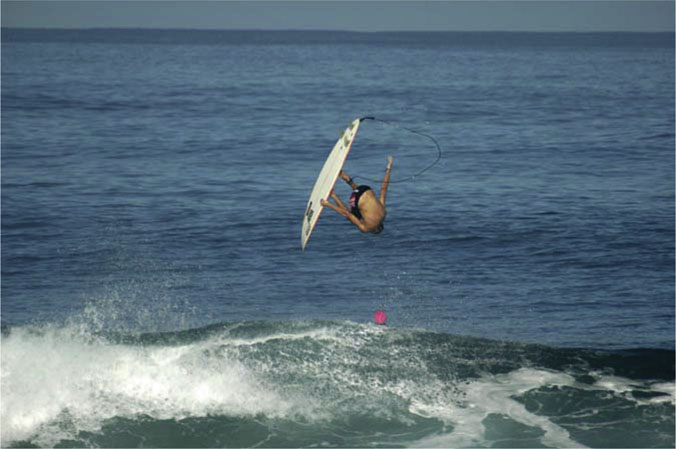
Photo by Dave Mead, Windowseat Pictures.
Arnold Schwarzenegger appeared in the 1987 film The Running Man, in which he fled for his life on a fictional reality-TV show. What made the film’s story ahead of its time is the likelihood that this may be where entertainment is actually going. Danny Way jumped the Great Wall of China, Travis Pastrana pulled a double backflip on a dirt bike — and what will happen next, no one knows. Action sports are progressive, and you have a unique opportunity to tell a captivating story. Just remember: media is an ever-evolving entity itself, and what is popular this year may not be next year.
MOVINg Forward
So Michael Moore makes personal statements, or “essays,” in the form of what once was the documentary, and of course reality TV and web shows are not actual reality. These are facts. If anything, these shows and movies should encourage you to think outside the box, look at what’s new in the world of media, and consider where things are going.
When you set out to make a documentary, you may have a basic idea of what you hope to get and how you’ll cut it together. There is no solid line as to what exactly is and isn’t a documentary. The idea that you are capturing real people doing real things is enough for most viewers. However, if you want to script your project — perhaps to make a commercial, perhaps a short series of webisodes or clips for the Internet — then you’ll need to decide early on.
Scripted shoots require much more organization and planning than documentaries do. You will have to decide well in advance who will be in what scenes and how you want those scenes to look and feel. The biggest difference between scripted shoots and documentaries is that scripted shoots often require more time, more crew, and more equipment. A typical documentary crew can be as small as you alone, to the more typical one cameraman, one sound person, and one producer (see Figure 7-2). This three-person documentary crew is all it takes to make a high-production-value project. So long as your camera and sound people are experienced, you can make a theatrical-ready project with this simple setup. Just keep in mind that the basic action-sports video is typically shot alone on a single camera.
Figure 7-2 Frame grab from the scripted “Danny Way Skater” clip, as seen on YouTube.
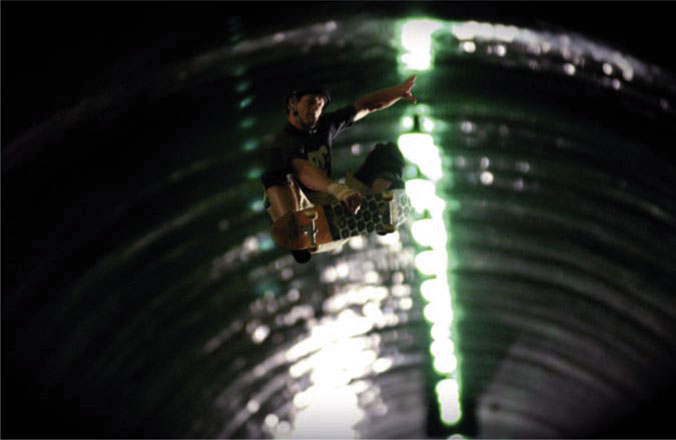
Scripted shoots can also be done with few people involved; however, they usually do take more time and more personnel to do them right.
Figure 7-3 A standard three-person documentary crew.

Photo by J. M. Kenny.
Of late, many action-sports videos have begun to intercut scripted elements (or story vignettes) within the action. From high-profile selections such as Birdhouse’s The End to under-the-radar small productions, you can find a decent selection of mixed-format videos out there. This growing format of mixing documentary and scripted shoots together is likely to stick around for quite a while as its popularity with most enthusiasts of action-sports video continues to grow. A main reason for this is the use of nonactors in the scripted clips. Although most athletes have had their share of time in front of a camera, most of them are not trained or experienced actors, which can add an element of entertainment or flat-out fun for the viewer. Getting to see an athlete you follow and enjoy featured in a video skit usually goes over quite well.
Getting the Interview
Many of these mixed-media-format projects also include typical action and interview fare. There are three basic types of interviews we are going to discuss: the OTF (on-the-fly) interview, the sound bite, and the sit-down interview.
OTF interviews are like sound bites. They happen on the go, in the moment, and usually with little or no planning. A good OTF can take place in the middle of a crowded room, on top of a ramp right before a contest, or even while skiing or snowboarding down the side of a mountain. The beauty here is that most OTFs capture the athlete in their natural environment. They allow for your shots to further the story of who this person is. A Summer X Games athlete putting on his pads as he gets interviewed is the perfect example of an OTF. It’s also nice that the OTF allows you to get both present tense and past. There has always been something so powerful about interviewees talking about what just happened when they are still standing in the moment at an event. This sense of urgency plays very well in both directions, past or present. If you ask an athlete what just happened or to describe what a friend did, you are basically getting an intro for the trick itself — a compartmentalized little story, if you will. On the other hand, if something is happening in the background as the interviewee is speaking, he or she can essentially be calling the shots in real time, giving you present-tense sound bites.
Which leads us to the next style of interview, the sound bite. This can be a very gray area as to when it stops being a sound bite and when it starts to become an OTF. In short, the sound bite is essentially an excerpt from a longer speech or a quick man-on-the-street comment. Although a sound bite can be as short as a few words, it can also run as long as several paragraphs. What makes it a sound bite is that it stands alone as a single item cut into something larger (more on this in Chapter 9, Postproduction). Some of the best sound bites happen with absolutely no setup or planning at all. Whether I’ve been on the deck of a ramp, by the ocean on the beach, or at the base of a ski resort, I can’t count how many times I’ve been rolling and just happened to get a random comment from someone close by.
Figure 7-4 Dave Paine shooting OTFs with BMX legend Mat Hoffman.
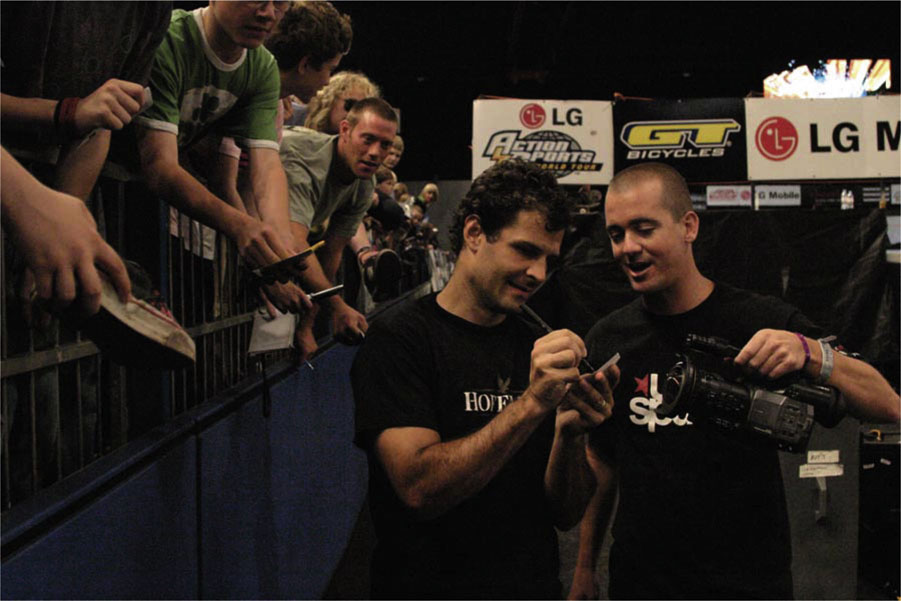
Courtesy ASA Entertainment.
When you interview an athlete, there are a multitude of questions you can ask. Some of the more typical ones asked at action-sports events are shown in Table 7-1. I always find that bringing a list of possible questions with me on a shoot or to an event can be a great help. If you haven’t done many interviews before, then make a list and review it before you go in for an interview. There’s nothing worse than finally getting that perfect moment with a top athlete and running out of things to ask!
Table 7-1 Popular questions asked at action-sports events
|
• Start with simple questions such as name, age, hometown. • Have them explain what’s going on or where they are. • Ask them why their sport’s important to them, why they do it. • Have them pick a rider they like, and talk about that person. • Ask them what makes great style. • Find out which competitor they think will win, and why. • Have them talk about how events compare to riding with friends. • Ask them about the most impressive thing they’ve seen today (or be specific — you should know which shots are your strongest). |
Another helpful tip that always sounds overly simple is this: as you’re talking to an athlete, remember to pay close attention to his or her answer. It’s very easy to focus too hard on what you want to ask next, and thus lose focus on what your interviewee is saying. You’ll find that a balance of each (what he or she is saying, and what you want to ask next) is necessary for a great interview. Consider what your next question will be as they’re speaking, while also thinking about what they’re saying and how to transition out of it. If you ask them about what they plan to do in their next run, and they begin talking about some pretty crazy tricks they are planning, then perhaps ask them next about the difficulty of those tricks or the fear involved. The key to a great interview is to listen and keep it flowing. Most athletes will give you more than enough time if they feel you aren’t wasting their time. Too much inappropriately timed silence or thinking on your part can send an athlete rolling away and end an interview early.
The final interview style is the sit-down interview; it’s the most thorough question-and-answer session you can set up. It usually requires a prearranged, more formal interview plan and a quiet location. Most sit-down interviews take place away from the noise of a major event because they tend to dig more deeply, with personal questions that may not relate to a specific event. A good rule of thumb is that the only time background noise should be heard is, first, if you can see it, then second, if it relates specifically to what is being discussed. For example, if an athlete is talking about his or her life as a skater in the city, and in the background you can see and hear traffic, then it’ll feel natural to the viewer. If you shoot them by a playground, however, and the sound of children yelling is audible but you can’t see them, it’ll likely be just a distraction. You’ll also have trouble editing the interview because the background noise may be inconsistent throughout it.
Interview Locations
Location is everything for interviews, from sound quality to distractions to what the background will look like. One of the most intriguing and unique interview setups I’ve ever seen was done for the Rail Jam at the Vans Cup Tahoe in 2006 and 2007 (see Figure 7-5). Director Bill Kiely worked with action sports DP (director of photography) Brooks Ferrell to create the very natural feeling of the interview set on the hillside right next to the competition. This is a perfect example of putting your subjects right into the action you might be hearing, while keeping the environment appropriate to the content.
Figure 7-5 Vans Cup Tahoe interview couch on the mountain.
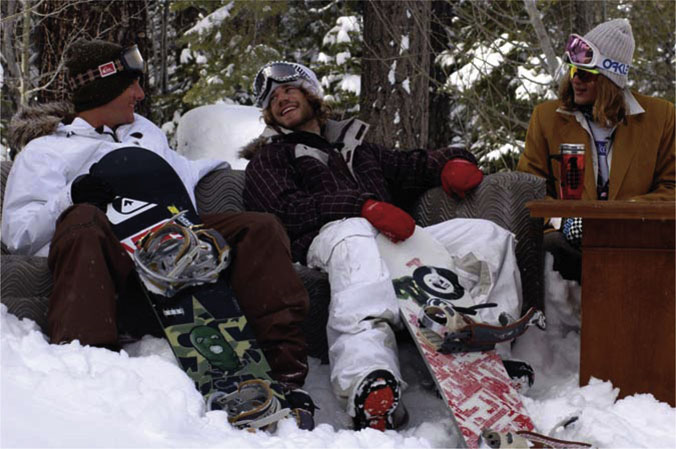
Courtesy Windowseat Pictures.
It’s always best to find a location that fits the vibe of the athlete or conversation. Many action-sports production companies will try to lock down a location for all their interviews, then run power out to it, set up lights, and bring athletes over to the area one at a time. The quality of a well-lit, patient interview will show, so if that’s your goal, then spend your time on it.
Although it will vary in importance to every interview, lighting is usually a key factor. Most interviews on location are shot OTF style, with no lights. On occasion, a single light (such as a sun gun), a bounce board, or diffusion for the bright sun will be used, but typically it is more raw and in the moment. Even night shoots often rely on existing lighting or a single onboard light for the camera. But sit-down interviews are different. Cameramen/DPs will usually try and take their time setting up lights and making the set look and feel comfortable. For this reason, interviews are often shot indoors or, at the very least, in the shade; the sun can be a very harsh source of light (for more on lighting, see Chapter 6, Shooting Techniques).
Don’t Be Afraid to Ask for What You Want
I spent a great deal of time early on in my career giving the interviewee too much power. When I would do question-and-answer sessions, I would be afraid to push where the interview was going, or I would be afraid to lead the questions in a direction that better fit my story. The truth is that when you’re interviewing, you have a choice: be a producer or be a director. Although some people argue there is no director in documentary filmmaking, it’s a much grayer area than that. Consider again Michael Moore, perhaps the greatest example of a man who directs his pieces with an admirable precision. His work may cover popular topics in reality, but they do so from a stance he believes in. Many argue that an opinionated stance is antithetical to the documentary process.
Figure 7-6 Snowboard filmmaker Chris Edmonds capturing life on the mountain.
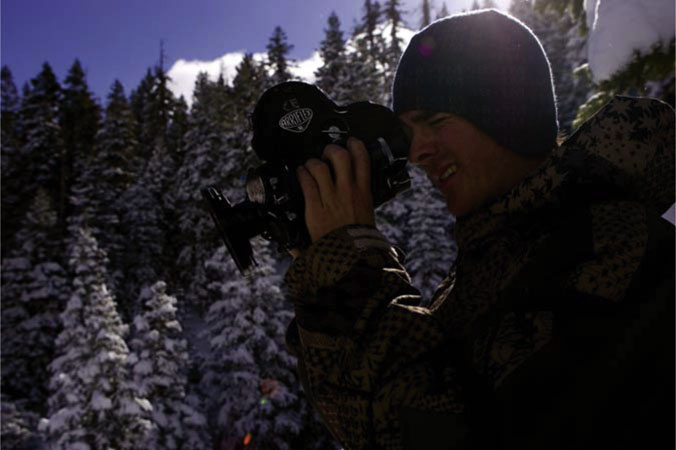
Courtesy Tim Peare.
Many filmmakers (that is, directors) don’t like to be called producers, even on documentaries where they are putting much personal style into the pieces and are hardly just producing them. This battle exists on projects of every size.
So how can you tell if you’re directing or if you’re producing? The answer can be as simple as your personal choice or as complex as dissecting how much and to what extent you are shaping the piece. If you lead the interviews, craft your story, isolate characters, and progress your story visually through your shots, then you are directing. If you simply show up, ask a provided list of questions, and hire someone to capture what is happening, then you are producing.
When it comes time to go after your interview with a strong goal and purpose, as a director would, you will need to think of your talent almost the way you would think of actors. The catch is that you can’t speak to an athlete interviewee the way you would an actor, so you must be clever and considerate. As you bring up topics you want to dive into, and as they begin to answer, you should identify the key elements of the answers that best fit your story, then ask them to go deeper in that direction. If you are creating a specific vibe or tone in your piece, then help bring them into that tone by setting the tone yourself. If you are rushing and speaking quickly, to keep an urgent feel to your piece, they’ll likely follow suit.
When I was shooting interviews for Harnessing Speed, I wanted several of my key interviewees to get their tone and attitude back to how it had been months ago for the subject they were discussing. So off camera, before I started asking questions, I had them go back to that day and talk a little about what had happened. This allowed them to freely revisit the emotions that they had felt early on, and then maintain that tone and feeling during the actual interview.
Now granted, there’s a fine line between guiding the interviewee and putting words into their mouth. It’s a line that you have to ride delicately and cautiously if you want your piece to be a real documentary. Most of my early interviews were simple; they incorporated the types of basic questions listed in Table 7-1. But as time progressed, I came to realize that the truly compelling interview actually requires you to get into someone’s head and help bring out of them the details and emotion that you won’t get when you stick to the surface questions.
Another interesting technique is to consider what tense they will be answering in. Most sit-down interviews happen after the fact, and are more or less recaps of an event from the past. This can give the viewer a more distant feeling of the event — a feeling that can work both for and against you. In some cases, you will want to try to re-create the power of what actually happened in the past. For this, I will sometimes have an interviewee outline what happened off camera, then, on camera, take me play by play through that event as if it were happening right then. For example, if an athlete landed an incredible trick for the first time, and you have ample B roll of that day to cut away to, then shoot for sound bites. Here’s an example: “I’m staring at the rail and thinking, ‘I can do this,’ but I know if anything goes wrong, especially with that drop on the other side, I could really hurt myself.” This technique can be very powerful for putting your viewer right there in the moment. It does, of course, require that you have enough footage of the subject to cut away to for most of the interview — such as shots of them looking at the rail, preparing to try it, noticing the big drop, and then going for it.
Figure 7-7 Pro-athlete interviews.
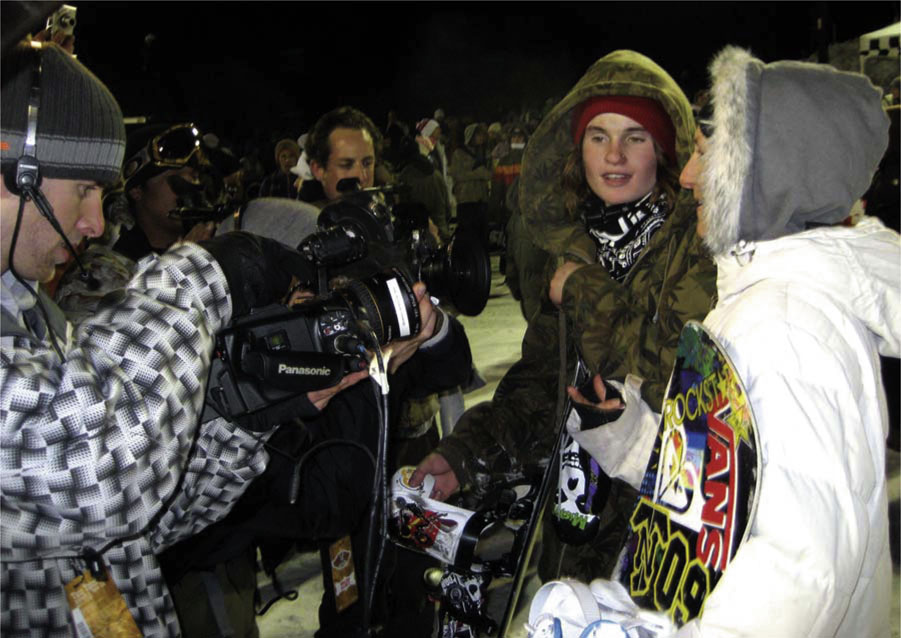
Every interviewer faces a delicate balance of pushing and getting compelling material without offending your subject. Especially in action sports, it’s critical that you maintain a friendly, easygoing relationship with the athletes you shoot. If you don’t know them personally, then go easy in the first interview (or at least the first interview questions), and feel out how far you can push things before you risk ruining the interview or the connection. Most athletes are used to interviews and the basic questions that most interviewers ask. They may not be used to more-meaningful or more-intense questions, so it can be helpful to prep them before the interview with what direction you plan to go in, to make sure they’re okay with that. Nobody likes to be blindsided on camera.
Although sound bites and OTF interviews will be the more common flavor you’ll encounter, I encourage you to push the boundaries of what’s normal and accepted. Be it for skate videos, documentaries, commercials, reality shows, or webisodes for the Internet, in the ever-changing medium of film and digital content, there is no right and wrong way to do it.
Notes
1 Merriam-Webster Online Dictionary (www.m-w.com).
